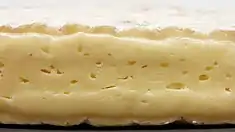Pont-l'Évêque cheese
Pont-l'Évêque (/ˌpɒ̃ ləˈvɛk, ˌpɒnt -/, French: [pɔ̃ levɛːk] ⓘ) is a French cheese, originally manufactured in the area around the commune of Pont-l'Évêque, between Deauville and Lisieux in the Calvados département of Normandy. It is probably the oldest Norman cheese still in production.[1]
| Pont-l'Évêque | |
|---|---|
 Pont-l'Évêque  Texture of Pont-l'Évêque | |
| Country of origin | France |
| Region | Normandy |
| Town | Pont-l'Évêque |
| Source of milk | Cow |
| Pasteurized | Frequently |
| Texture | Soft, washed rind |
| Fat content | Depends on variety |
| Aging time | 4-6 weeks |
| Certification | AOC 1976 |
Pont-l'Évêque is an uncooked, unpressed cow's-milk cheese, square in shape usually at around 10 cm (3.9 in) square and around 3 cm (1.2 in) high, weighing 400 grams (14 oz). The central pâte is soft, creamy pale yellow in color with a smooth, fine texture and has a pungent aroma. This is surrounded by a washed rind that is white with a gentle orange-brown coloration. The whole is soft when pressed but lacks elasticity. It is generally ranked alongside Brie, Camembert, and Roquefort as one of the most popular cheeses in France.
History
The cheese has been made in Normandy since at least the 12th century, and was allegedly first made by Cistercian monks who had settled west of Caen.[2] Originally known as "cherub", it later took the name "angelot". Becoming popular across the country from the 16th century onwards, it then acquired the name of the village around which its production was centred.
Manufacture
Pont-l'Évêque was recognised as an Appellation d'Origine Contrôlée (AOC) cheese on August 30, 1972, reaching full status in 1976. Its production was defined and protected with a decree of December 29, 1986.[3] Le Petit Futé guides commend that the best AOC Pont-l'évêque comes from the Pays d'Auge, which includes the Canton of Pont-l'Evêque itself.[4][5]
The AOC regulations include the following restrictions:
- The milk must come from a controlled area around the village of Pont-l'Évêque, extending to the départments of Calvados, Eure, Manche, Mayenne, Orne and Seine-Maritime.
- The curd must be successively divided, kneaded and then drained.
- During affinage the cheeses must be washed, brushed and turned.
- The resulting cheese must be one of three sizes:
- Petit – 8.5–9.5 cm square, and a minimum of 85g of dry matter.
- Demi – 10.5–11.5 cm by 5.2–5.7 cm, with a minimum of 70g of dry matter.
- Grand – 19–21 cm square, with a minimum of 650g of dry matter.
The affinage lasts at least two weeks after production, though most are left for over six weeks.
The cheese is around 45% fat as a percentage of dry matter and is manufactured throughout the year. Regulations currently allow either pasteurized or unpasteurized milk to be used for its manufacture.
The annual production is around 3,500 tonnes, of which the majority is made by two large producers. Only 2% of the production is classed as fermier. Acclaimed manufacturers include Bisson et fils, Lanquetôt, Lepeudry, and Levasseur.
Recipes include use in three-cheese fondue together with livarot and camembert, to accompany tournedos de veau.[6]
See also
References
- Leanne Kitchen The Dairy 2008 - Page 149 "Pont-l'évêque - Named after the village in Normandy where it supposedly first appeared, this cheese is one of the most popular in France. An old cheese, it dates from at least the 12th century, when it was made by monks; it was once known as 'white meat' as it was eaten instead of meat on fasting days .. Pont l'évêque is a cow's milk cheese, with a full, rich, sweet, slightly tangy flavour profile and a thin brownish rind; it is very similar to livarot, another washed-rind......"
- "History of Pont l'Eveque website". Archived from the original on 2014-08-14. Retrieved 2014-08-01.
- Le Petit Futé Normandie - Page 58 2011 "Une Appellation d'Origine Contrôlée permet à un fromage de se distinguer. ... Le meilleur du pont-l'évêque vient du pays d'Auge; quant au livarot, il est fabriqué au sud-ouest du Calvados et au nord-ouest de l'Orne."
- Le Petit Futé Deauville - Honfleur 2012 (avec cartes, photos + avis des lecteurs) - Page 44 2012 "L'étiquette « Fabriqué en Normandie » ne signifie pas, par exemple, que le fromage a été élaboré avec du lait normand ! Dans le cas de l'AOC on est certain ! Le pont-l'évêque et le livarot ont également obtenu leur AOC. Le meilleur du pont-l'évêque vient du Pays d'Auge..."
- Isabelle Cauty, Jean-Marie Perreau - Conduite du troupeau bovin laitier - Page 32 2009 "les fromages à pâte molle à croûte lavée (la croûte subit, au cours de l'affinage, des lavages et des brossages à l'origine d'un goût plus marqué) ex : le Munster, l'Epoisses, le Maroilles, le Pont-l'évêque, le Livarot, le vacherin... "
- Le Petit Futé Rouen - Page 26 ed. Jean-Paul Labourdette, Dominique Auzias, Caroline Sainsard - 2010 "S'il n'y en avait qu'une à faire, ce serait le tournedos de veau poêlé et sa fondue aux trois fromages: livarot, pont-l'évêque et camembert. In-con-tour-na-ble. Et puis si vous terminez par les poires pochées à la crème de whisky, vous saurez ..."